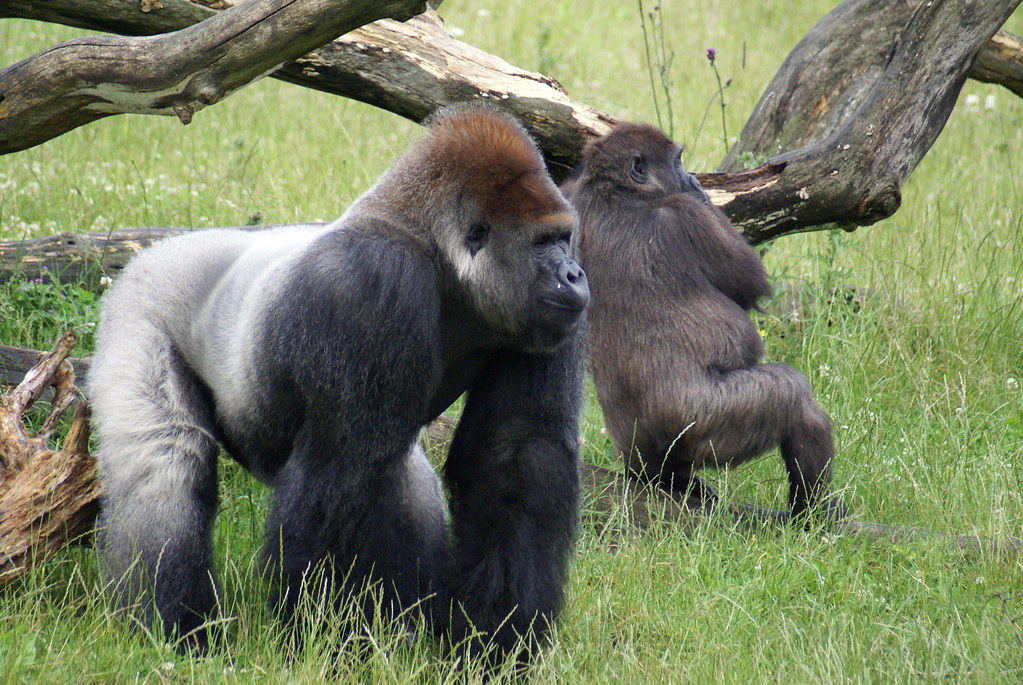9.4 Primate Sex Differences
While evidence suggests that in primate groups males and females are equally important to social life, this still leaves open the question of biological differences and their link to behavioral differences. The anatomy of primate males and females differs in two main respects. Of course, adult females can and often do experience pregnancy and bear offspring. The females of most primate species are often pregnant or nursing for most of their adult lives and devote more time and resources to care of young than males do (although there are some notable exceptions, such as certain species of New World monkeys). And some researchers have noted the tendency of juvenile females to pay more attention to primate babies in the group than do juvenile males.
Male primates tend to be slightly bigger than females, although this difference itself is quite variable. The size difference between males and females of any species is referred to as sexual dimorphism. Male and female gibbons are nearly the same size, while male gorillas are nearly twice the size of females. Female chimpanzees are about 75 percent the size of males. Human females are about 90 percent the size of males, making human sexual dimorphism closer to gibbons than chimpanzees. This suggests hominins evolved to be monogamous – a point we return to in the next section.

In addition to dimorphism, studies using proportional measurements of testes size seem to also point to the relative monogamy of a species. In general, the more monogamous a species, the less sperm competition there is between males. This is due to the reduced likelihood that a female will mate with multiple males. As such, sperm count can be lower, and testes size is smaller. For example, gorillas living in a single male, multifemale social group experience little intrasexual competition for mates. Accordingly, despite the significance in size, gorilla testes are about the size of a kidney bean. Relatively, this is half the average size of human males! In contrast, chimpanzees are extremely competitive, sometimes dominating females during her entire reproductive cycle to prevent other males from mating. As expected, their testes are much larger for their body size – nearly the size of a tennis ball compared to a human male.
Based upon the slight dimorphism between human males and females, humans likely evolved a form of mating that is somewhere between gorillas and chimpanzees. This is supported by the relative testes size of the average human male. Additionally, human females are among the only known mammal with concealed ovulation. Combined, this evidence supports the notion that humans evolved to have mutual mate choice and multiple, though monogamous, matings over time.
Humans’ closest primate relatives are chimpanzees and bonobos, both sharing approximately 99 percent of their DNA with humans, and yet each species exhibits strong sex differences in behavior. Bonobos are female-dominant, while chimpanzees are male-dominant. Bonobo groups are mostly egalitarian and peaceful, while chimpanzee groups are intensely hierarchical, with frequent male aggression between groups. Sexual behavior among bonobos is remarkably frequent and extraordinarily variable, with a wide range of same-sex and opposite-sex pairings involving various forms of genital contact. Some researchers believe that sexual contact helps build social bonds and ease conflicts in bonobo groups. Bonobos have been called the “make love, not war” primate. Sexual behavior among chimpanzees is also variable but much more limited to opposite-sex pairings. A female in estrus may mate with several males, a pattern called opportunistic mating. Short-term exclusive relationships may form, in which a male guards a female to prevent other males from mating with her. Consortships also happen, in which a female and a male leave the group for a week or more.
With such variability between our two closest DNA relatives, it is impossible to use nonhuman primate behavior to make assumptions about what is “natural” for human males and females. In fact, with regard to gender, the lessons of primatology may be that apes (like humans) are biologically quite flexible and capable of many social expressions of gender and sexuality. I recommend reading Frans de Waal’s 2022 book, Different: Gender through the eyes of a primatologist.
distinct difference in size or appearance between the sexes of an animal in addition to difference between the sexual organs themselves.
the lack of any perceptible change in an adult female when she is fertile and near ovulation.

